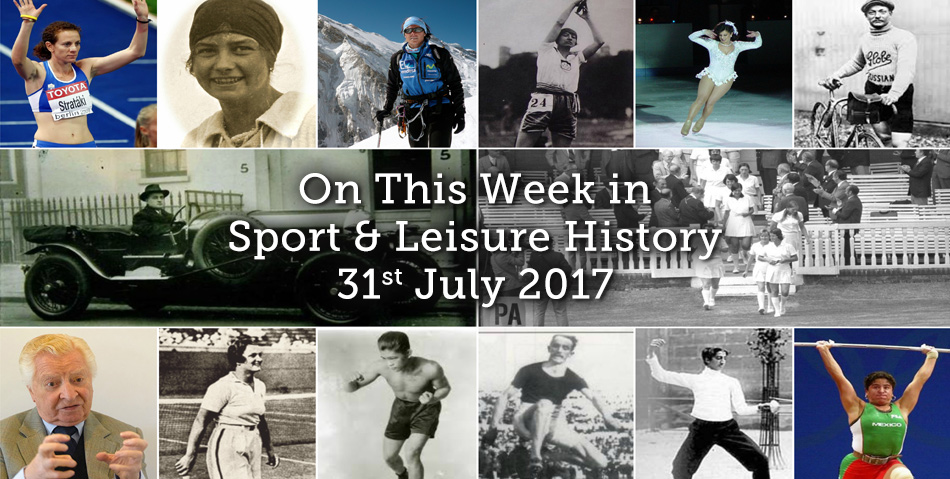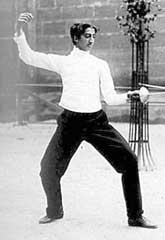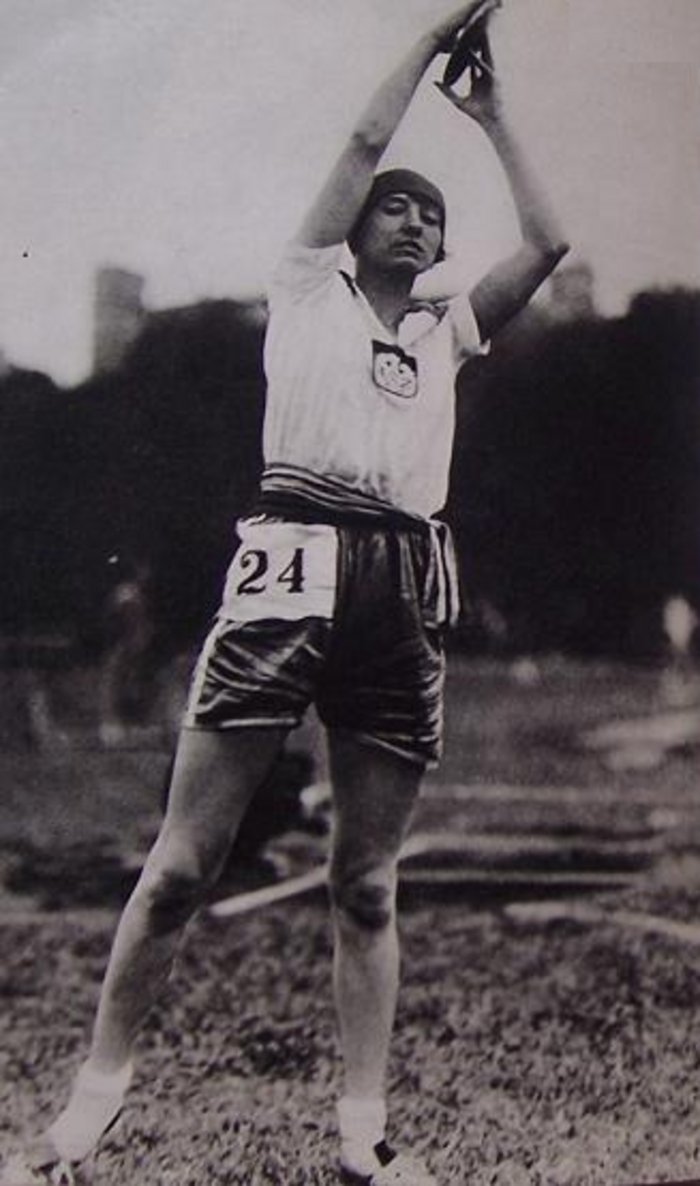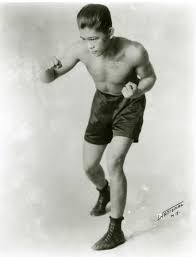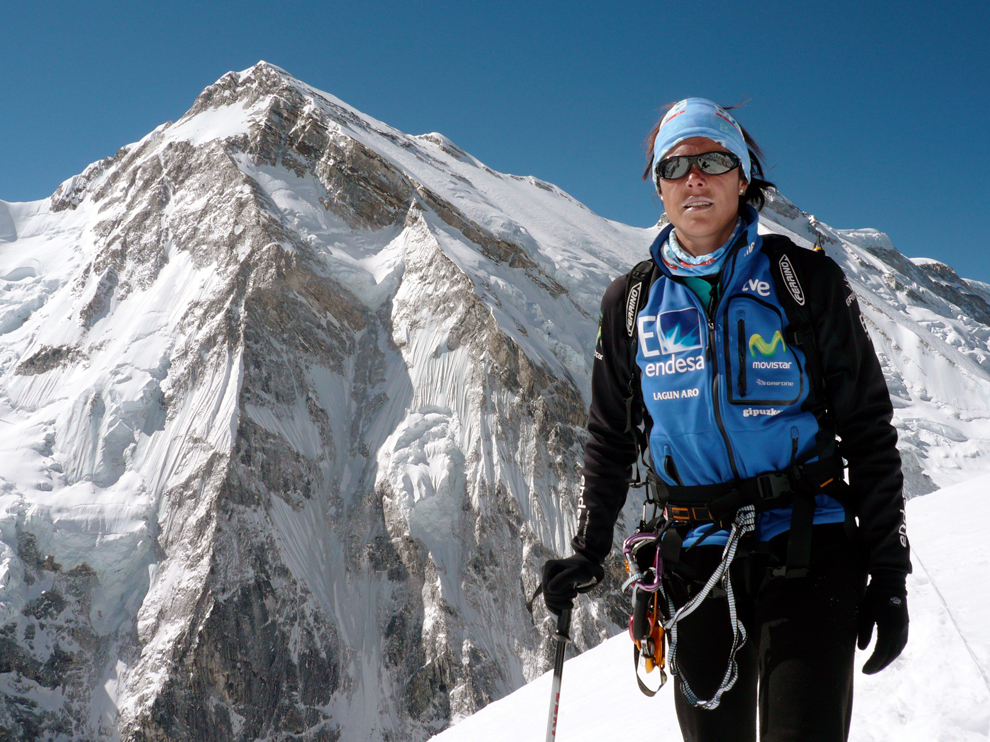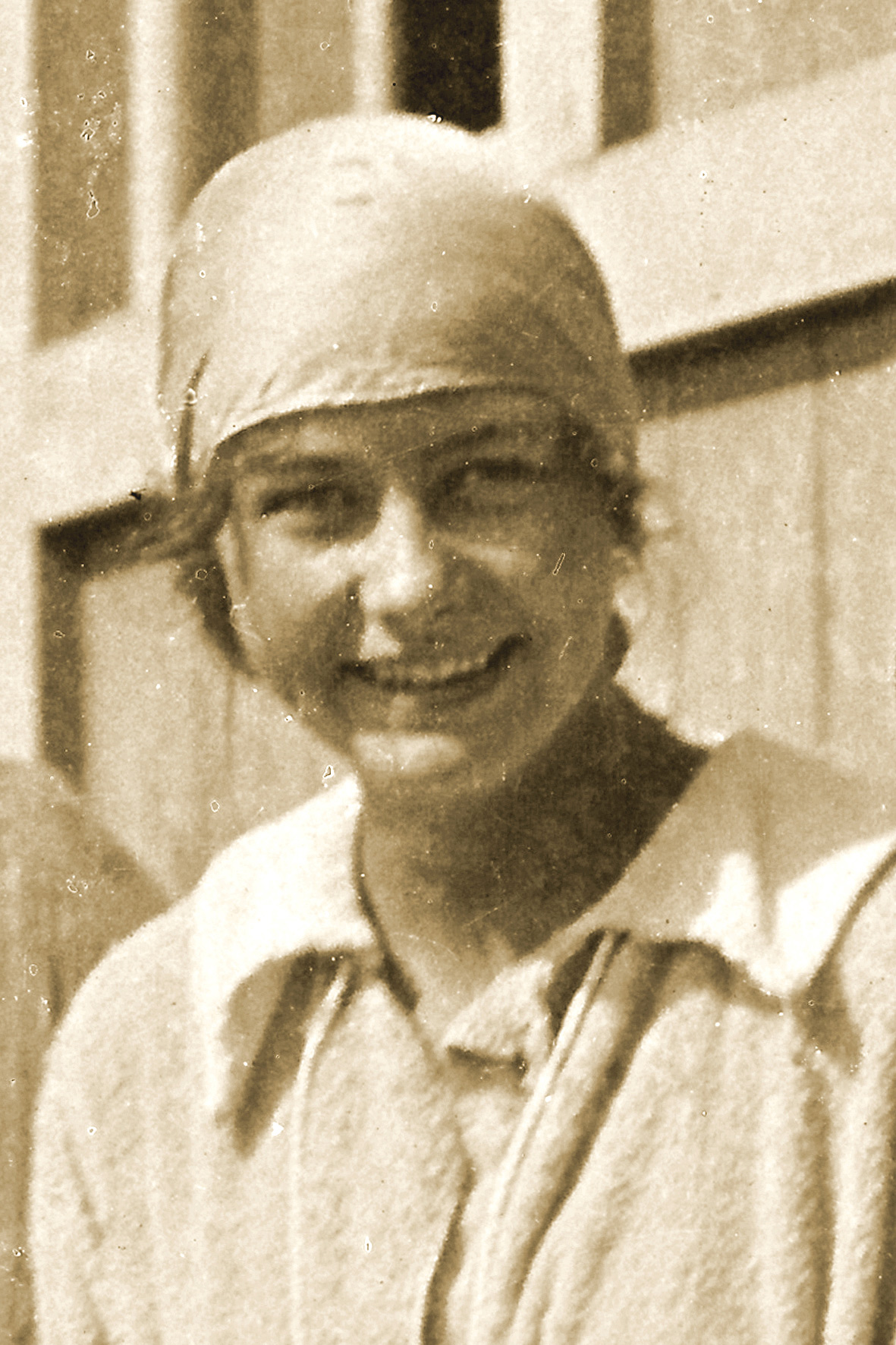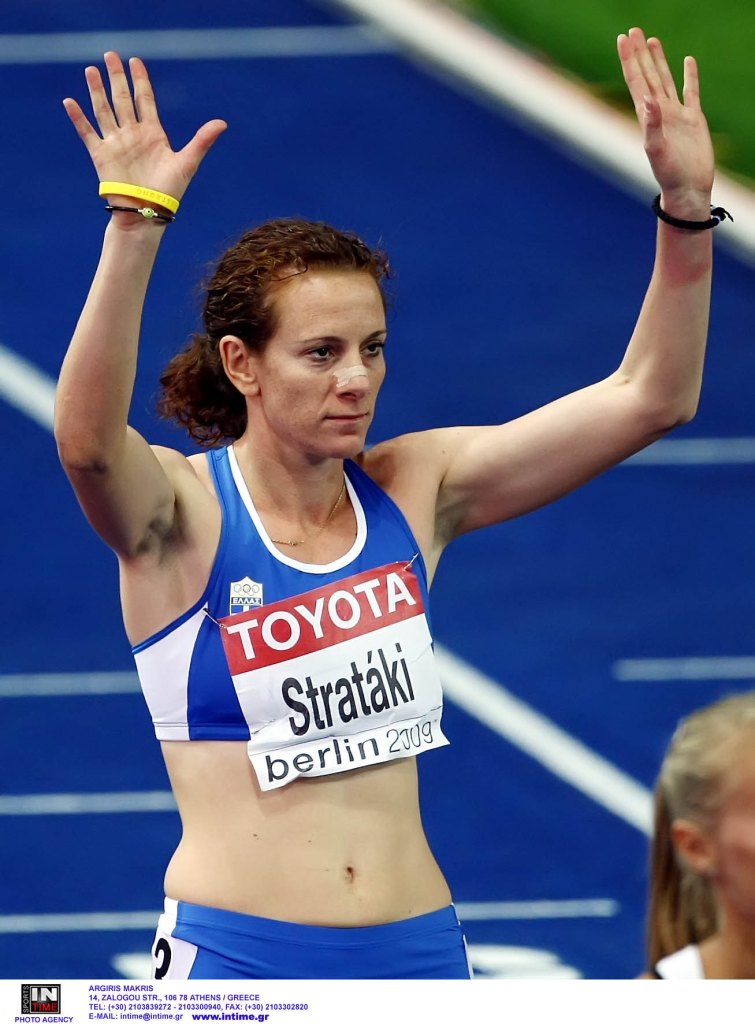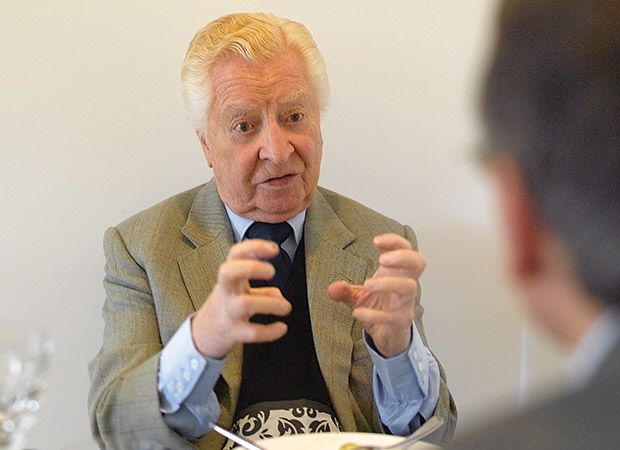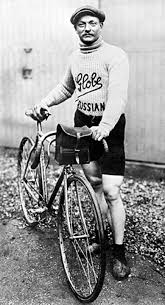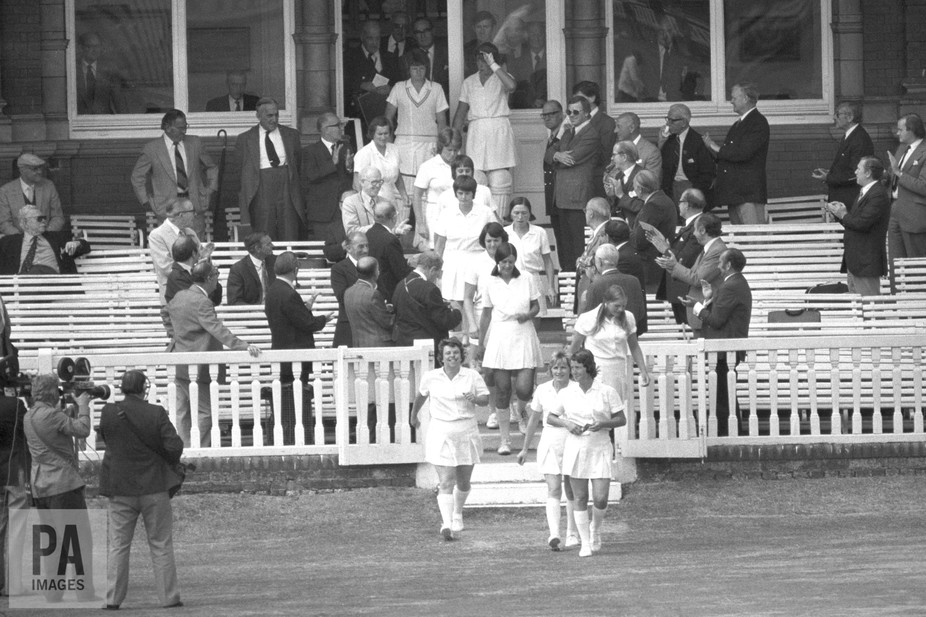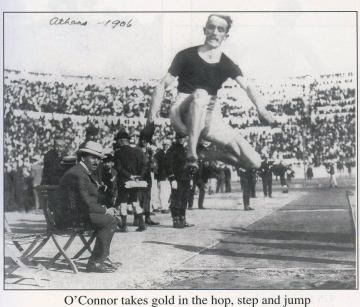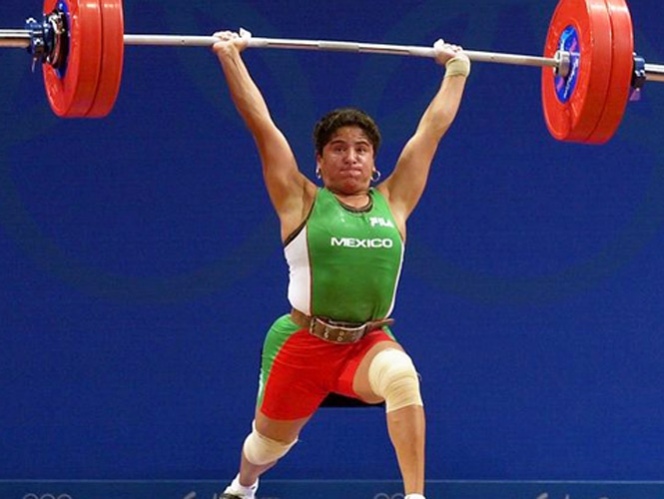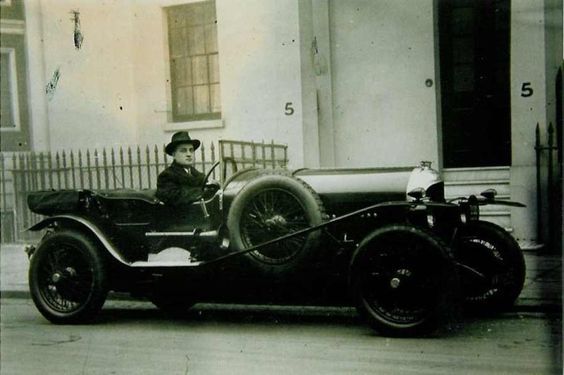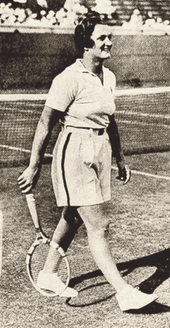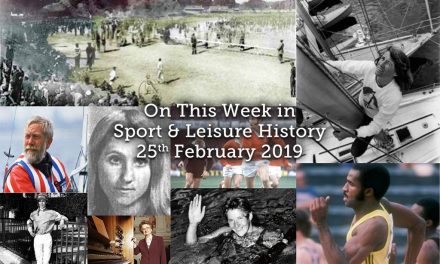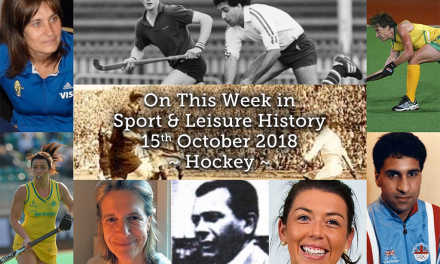31st – Ramón Fonst Cuban fencer was born today in 1883. Although born in Cuba, he spent most of his youth in France, where he received his fencing education, and aged just 16 years he entered the 1900 Olympics Men’s épée event. He was up against another 101 fencers from 10 other countries, in his first-round group he came out top against the five fencers from France, so advanced into the next round, where he only managed to finish third but was still good enough to advance to the semi-finals and again he would finish third in the group and so qualifying for the final. In the final, Fonst was up against seven French and one Argentine fencer, and against the odds (and the judges) he won four of his six matches to win the gold and so became the first Cuban and first Latin American medallist on the Olympic stage. A few days later, Fonst competed in the Men’s amateurs-masters épée which put the top four amateurs with the top four professionals at the Games, Fonst managed to win six of his seven contests and won the silver medal, his only defeat was against the French professional Albert Ayat who went on to win the gold medal. Four years later, Fonst was in St.Louis, Missouri, competing at the 1904 Olympics, and within two days he won three gold medals, he retained his Olympic title in the Men’s épée, and added the Men’s foil title and under the Mixed team banner he won the Men’s team foil event with fellow Cuban Manuel Díaz and American Albertson Van Zo Post. Cuba didn’t compete in the Summer Olympics again until 1924, which was again held in Paris. Now aged 40, Fonst again competed in the Men’s épée but this time only managed to reach the semi-final, he also competed in the Men’s team épée but they were knocked out of the competition in the quarter-finals. After his career as an active sportsmen Fonst became president of the National Olympic Committee fo Cuba, as well as an adviser for the Department of Physical Education and Sports, which he served until he died from a diabetic coma in 1959, aged 76 years old. The former England cricket captain GO ‘Gubby’ Allen was born in 1902. He was three months short of his 46th birthday when he played in his 25th and last Test match in the West Indies in 1948. He died in 1989 aged 87. In 1910 8th Tour de France was won by Octave Lapize of France. Indian cricketer and coach Hemu Adhikari was born in 1919, his career spanned three decades. A talented right-handed batsman and occasional leg spin bowler, he made his [first-class cricket first-class] debut as a teenager before the outbreak of World War II in the 1936/37 domestic season. He immediately demonstrated his abilities on the local stage but due to the war, and his role in the Indian armed forces, his career was interrupted. Adhikari made his Test debut as a 28-year-old in 1947 on India’s tour of Australia and immediately established himself as an important member of the squad, although his continued official role in the army restricted his availability for the team. He took to coaching after retiring from first-class cricket – with a very good batting average of 41.74 – and was in charge of the Indian team as they established themselves on the world stage. He helped guide India to their first series win in England in 1971 and was a major reason behind the development of such outstanding cricketers as Sunil Gavaskar, Kapil Dev and Ravi Shastri. Some felt his history with military helped him as a coach, with former national team spin bowler Bapu Nadkarni saying “Adhikari was a disciplined man. Being a military man, he would not bother about what anybody else thought.” On this day in 1928 Halina Konopacka of Poland became the first female track and field Olympic gold medallist, when she broke her own world record with a throw of 39.62 metres to claim victory in the discus at Amsterdam. On this day in 1936 Tokyo was awarded the 1940 Olympics, later cancelled due to WWII. Heather McKay, the most successful female squash player in this history of the sport, was born in 1941. Australian-born, she held the British Open title for 16 years between 1962 and 1977. She also won the World Open title in 1976 and 1979. Charlie William, British Grand Prix motor-cyclist was born in 1950, his best season was in 1974 when he finished in tenth place in the 500cc world championship on a Yamaha. Williams was an eight-time winner at the Isle of Man TT races, although only three of those victories counted towards the world championship. In 1980, he won the Formula II Class of the Formula TT world championship. Since racing, Williams has remained a TT personality presenting the breakfast show every week day on Radio TT as well as joining the team for trackside commentary. He owns and has taken an active role in running the Chester store Everything But Bikes since retiring from TT racing. Australian tennis star Evonne Goolagong (later Crawley) was born in 1951. She beat fellow Australian Margaret Court to win her first Wimbledon title at the age of 20 in 1971. Almost a decade later, in 1980, she beat Chris Evert to win her second title. The most remarkable bowling feat in the history of Test cricket was completed at Old Trafford in 1956 when Jim Laker took his 19th Australian wicket for 90 runs. He had taken 9 for 37 in the first innings and followed that by taking all 10 Australian wickets for 53 runs in the second innings. England won the Test, the fourth in the series, by an innings and 170 runs. Peter Senior, Australian golfer who won more than twenty world-wide tournaments was born in 1959. He has competed mainly on the PGA Tour of Australasia, where he has had the most success and won the Order of Merit on four occasions, and the European Tour. He has also played occasionally on the Japan Golf Tour and the United States-based PGA Tour. Senior has represented Australia in international competitions several times, and was a member of the International Team at the first two stagings of the Presidents Cup. He has also represented Australia twice at the World Cup. At the London Olympics in 2012, Michael Phelps takes the record set in 1964 by Larisa Latynina for the most medals won at the Olympics.
- Ramón Fonst
- Halina Konopacka
1st Aug – The oldest surviving sporting contest, the Doggett’s Coat and Badge, for Thames sculler, was first held in 1716. It was the idea of Irish comedian Thomas Doggett. Filipino boxer Francisco Guilledo, more commonly known as Pancho Villa, was born in 1901. Villa, who stood only 5 feet and 1 inch (154 cm) tall and never weighed more than 114 pounds (51kg), despite the racial discrimination of that time, rose from obscurity to become the first Asian to win the World Flyweight Championship in 1923, earning the reputation in some quarters as one of the greatest Flyweight boxers in history. He was never knocked out in his entire boxing career, which ended with his sudden death at only twenty-three from complications following a tooth extraction. On this day in 1907 the first Scout camp on Brownsea Island began. The Brownsea Island Scout camp started as a boys’ camping event on Brownsea Island in Poole Harbour, organised by Lieutenant-General Baden-Powell to test his ideas for the book Scouting for Boys. Boys from different social backgrounds participated from 1st-8th August 1907 in activities around camping, observation, woodcraft, chivalry, lifesaving and patriotism. Recognised as the world’s first Scout camp, the event is regarded as the real origin of the worldwide Scout movement. Today in 1911 Harriet Quimby took her pilot’s test and became the first US Woman to earn an Aero Club of America aviator’s certificate. American tennis player Jack Kramer was born in 1921. The Wimbledon champion in 1947, he won successive US titles in 1946 and 1947. A pioneer of the professional game in the 1950s, he later found fame behind the microphone. Notable roller derby personality American Ann Calvello was born in 1929. Calvello had competed in roller derby during seven decades: the 1940s until the 2000s. She broke into the sport in 1948 originally skating for a league called International Roller Speedway. She travelled the world skating in Europe, Guam, Philippines, Cuba, Australia and of course all over the United States. Following her initial retirement, in 1968, she was inducted into the Roller Derby Hall of Fame. In 2001, Demon Of The Derby, a biographical documentary film about Calvello, was completed by Fireproof Productions. In 2005, Calvello contributed many rare photos and clippings from her personal collection to the book Roller Derby Classics…and more! by Jim Fitzpatrick and also wrote the foreword to the book. The XIth Olympics opened in Berlin in 1936. Hitler used the Games as a propaganda vehicle to promote his idea of Aryan supremacy. The black athlete Jesse Owens turned this notion on its head by winning four gold medals. Edurne Pasaban, Basque Spanish mountaineer, from Tolosa, was born on this day in 1973. On May 17th 2010, she became the 21st person and the first woman to climb all of the fourteen eight-thousander peaks in the World. Her first 8,000m peak had been achieved 9 years earlier, on May 23rd 2001, when she climbed to the summit of Mount Everest. Polish mountain biker Marek Galiński was born in 1974. During his sporting career, he won nine Polish national championship titles and a silver medal in men’s cross-country racing at the 2003 UCI World Cup series in Sankt Wendel, Germany. Galinski also represented his nation Poland in four Olympic Games (1996, 2000, 2004, and 2008), where he competed in men’s mountain biking from the time that it officially became an Olympic sport in 1996. Galinski raced professionally for more than five seasons on the JBG2 Professional MTB Team. After his retirement from the sport in 2011, Galinski worked as an assistant coach of both Polish and Russian mountain bike national teams. Upon his return from a training camp in Cyprus on 17thMarch 2014, he was killed in a car accident near Jędrzejów. The Montreal Olympic Games ended on this day in 1976. Also, today in 1976 Formula One racing driver Niki Lauda was in a critical condition in hospital after an horrific accident at the Nurburgring Grand Prix in Germany. The Austrian-born driver became trapped inside his Ferrari after it swerved off the track before bouncing back into the path of the oncoming cars and catching fire. Fellow driver Guy Edwards managed to avoid the blazing wreckage but Harald Ertl and Brett Lunger both hit it. All three drivers raced to the burning Ferrari and, with the help of the Italian driver Arturo Merzario, who also stopped, eventually managed to pull 27-year-old Lauda from his vehicle. Within six weeks of the accident Lauda was back behind the wheel. He fought for his life for several days following the accident and suffered horrendous burns to his head and face. Part of one of his ears was burnt off and his tear duct mechanism was severely damaged which affected his vision in subsequent races. Lauda won the World Championship a total of three times – in 1975, 1977 and 1984. He retired from F1 in 1985. Before the 1976 accident he had been well on course to win it again – but eventually lost by just one point to James Hunt. At the end of the 1970s he launched his own airline Lauda Air, which was later sold to Austrian Airlines. He managed the Jaguar F1 racing team from 2001-2. In late 2003 he launched another airline, Niki. Guy Edwards was awarded a Queen’s Gallantry Medal for his bravery. Six days after losing to Steve Ovett in the 800m final at the Moscow Olympics in 1980 Sebastian Coe turned the tables by beating Ovett into third place to win the 1500m gold. Jurgen Straub of East Germany taking silver. Elena Vesnina, Russian tennis player, whose career-high rankings are World Number 13 in singles and World Number 3 in doubles was born today in 1986. Vesnina is a four-time Grand Slam champion in doubles competition, having won the 2013 French Open, 2014 US Open, and 2017 Wimbledon Championship tournaments with Ekaterina Makarova, and the 2016 Australian Open mixed doubles title with Bruno Soares. Australia won the fourth Test at Old Trafford in 1989 to become the first Australian side to regain the Ashes in England since 1934; it was also Australia’s 100th win over England. On this day in 1996 the British tennis player Katie Boulter was born. She has won two singles and four doubles titles on the ITF tour in her career. On 26th June 2017, she reached her best singles ranking of world number 235. On 24th November 2014, she peaked at world number 473 in the doubles rankings. Boulter was ranked the number ten junior tennis player in the world in March 2014. She is based at the Lawn Tennis Association’s National Tennis Centre in Roehampton and is coached by Jeremy Bates and Nigel Sears. Today in 2008 eleven mountaineers from international expeditions died on K2, the second-highest mountain on Earth in the worst single accident in the history of K2 mountaineering. At the 2012 London Olympics 8 Women’s badminton doubles players were disqualified for “not using one’s best efforts to win a match”
- Pancho Villa
- Edurne Pasaban
2nd–Tommy Ward, South African cricketer who played in 23 Tests from 1912 to 1924, was born today in 1887. His debut Test was on 27th May 1912, the opening Test of the 1912 Triangular Tournament between South Africa and Australia at Old Trafford. Ward found himself facing the hat-trick ball of Australian bowler Jimmy Matthews. Matthews had just got the wickets of Rolland Beaumont (31) and Sid Pegler (LBW for 0). Facing his first ball in Test cricket, Ward was hit on the pads and was given out LBW, earning himself a golden duck on debut and giving Matthews his hat-trick. South Africa fell well short of the Australian’s first innings total and were forced to follow on. In South Africa’s second innings, Matthews again got two wickets in two balls, Herbie Taylor (21) and Reginald Schwarz, caught and bowled for 0. Ward for the second time in his debut match found himself walking to the crease to face Matthews on a hat-trick. Matthews got Ward out caught and bowled giving Ward his second golden duck (king pair) for the match and Matthews his second hat-trick. This has been the only time in Test cricket history where two hat-tricks have been taken in the one match. Ward died in 1936 as a result of accidental electrocution while working at a gold mine. The Hungarian fencer Ernő Nagy was born in 1898. He won a gold medal in the team sabre at the 1932 Olympics. He retired from competition in 1938, at which point he became head of the fencing section of the Hungarian Athletics Club. Roy Crimmins, English jazz trombonist, composer and arranger was born on this day in 1929. Of Irish and English descent, Crimmins turned professional by joining the Mick Mulligan band in 1952. Originally self-taught, Roy was later mentored by the American bass trombonist with the Philarmonia Orchestra, Ray Premru, and the then Ted Heath principal trombonist, Don Lusher. With a career spanning 50 years, Crimmins has played and collaborated with many notable musicians, including Duke Ellington and Louis Armstrong. In the mid-1980s Crimmins was approached by the Mayor of Eilat, Israel, to advise on establishing an International Jazz Festival in Eilat. Roy’s involvement in this venture led to the renowned Red Sea Jazz Festival. Soon after, Roy and his family moved to Tel Aviv where he established the Israel Jazz Ensemble, and was commissioned by Musica Nova (a breakdown group from the Israel Philharmonic Orchestra) to write a concerto, which premiered in the Tel Aviv Museum of Art to great acclaim. In 1936 the 30th Tour de France was won by Sylvere Maes of Belgium. The former Northern Ireland footballer Sammy McIlory was born in 1954. A member of the successful Manchester United team of the 1970s, he scored a goal on his debut for the club in the Manchester ‘Derby’ in 1971. He made over 400 appearances for united before moving to struggling Stoke City and then returning to the top flight with Manchester City. He played for Bury and then moved to Sweden. He won 88 Northern Ireland caps. Arshad Ayub, Indian cricketer was born today in 1958. He played in 13 Tests and 32 ODIs from 1987 to 1990. In January 2010 he became the manager for the Indian Cricket team for the ODI’s and Test-series held in Bangladesh. He is also the president of HCA. American figure skater Linda Fratianne was born on this day in 1960, the winner of two World Championship titles (1977, 1979), four consecutive U.S. Championships (1977–1980), and a silver medal in the 1980 Winter Olympics. Mike Tyson beat the IBF champion Tony Tucker on points over 12 rounds at Las Vegas in 1987 to become the first universal world heavyweight champion since Leon Spinks in 1978. Also on this day in 1987 the 25th Tennis Fed Cup was won by Germany after beating the US in Vancouver 2-1. Suzie O’Neill, Australian Olympic swimmer, nicknamed “Madame Butterfly”, was born in 1973. O’Neill excelled in sport, setting school records in 50m and 100m butterfly, freestyle, and backstroke. She was also cross country champion and set records for the 13 years 800m in 1986 and for the 15 years 400m in 1988 for athletics, most of these records still stand to this day. O’Neill won the 200m butterfly at the 1996 Olympics and the 200m freestyle at the 2000 Games. She won 35 Australian titles and with eight Olympics medals, among Australians, only Ian Thorpe and Leisel Jones have more. After winning a gold and a silver medal in her first attendance at a competition at the 1990 Commonwealth Games, O’Neill never failed to win a medal at any international meet she attended, right up until her final Olympics in front of a home crowd in Australia. At the Sydney 2000 Olympic Games Trials, she broke the 19-year-old world record of another “Madame Butterfly”, Mary T. Meagher, in the 200m butterfly, but was beaten at the Sydney 2000 Games by American Misty Hyman, in an upset. Kenyan middle and long distance runner Reuben Kosgei was born on this day in 1979, mostly famous for 3000m steeplechase in which he became the youngest ever winner of an Olympic gold medal in the event when at the age of 21 he ran to victory Sydney 2000 with a winning time of 8 minutes 21.43 seconds. At the 2006 Commonwealth Games he won a bronze medal in the steeplechase race. He made his marathon debut at the 2009 Vienna Marathon, but did not finish the race. He finished 2nd at the 2009 Florence Marathon. A regular visitor to Australia, Kosgei won the 2009 Sydney Morning Herald Half Marathon in 64:18 and returned in 2010 to place 3rd in Perth’s City to Surf Marathon. He won the 2011 Perth City to Surf 12 km event, the 2011 Bridge to Brisbane fun run, the 2011 Adelaide City-Bay fun run and most recently, came second in the 2015 Adelaide City-Bay fun run. Stefanie Fryland Clausen died on this day in 1981 aged 81. The champion in the Plain High Dive for women from the 5m and the 10m platform at the Olympic Games in Antwerp in 1920. She thus became the first Danish woman to win Olympic gold and indeed the first Dane individually, as the previous Danish gold medal winners were as members of a team. Snooker player Ronnie O’Sullivan’s record of 38 consecutive wins in tanking tournaments was ended in 1992 by Sean Story. The 85th edition of the Tour de France in 1998 was won by Marco Pantani of Italy. Russian-born Israeli chess Woman Grandmaster Alla Kushnir, who emigrated to Israel in 1974, died on this day in 2013 aged 71. She was three times Women’s World Chess Championship Challenger consecutively, losing matches for the title to Nona Gaprindashvili in 1965. 1969 and 1972. Kushnir was a three-times winner of the Women’s Chess Olympiads: in 1969 and 1972 she won the tournament as a player in the Soviet team, both times showing the best result at the 2nd board and in 1976 she won it as a player of the Israeli team, also showing the best result at the 1st board.
- Linda Fratianne
- Stefanie Fryland Clausen
3rd -On this day in 1852 the first Harvard-Yale Regatta was held. Yale University founded the first US collegiate crew team in 1843. The next year, Harvard created their own team. They were mostly social in purpose until 1852. Yale challenged Harvard to see which school produced the best oarsmen. The two teams met on this day, creating the first American intercollegiate sporting event. There were three boats on the water that day. They covered a two-mile course. The winning team was awarded a pair of black walnut, silver inscribed rowing oars. They were presented by General Franklin Pierce who would become the 14th President of United States the next year. Yale’s Undine finished third, second place – two lengths behind the winner – was Shawmut, also owned by Yale. The Harvard boat, Oneida, won. Since 1859, the contest has been held annually except during major wars. The first year, the contest was held at Lake Winnipesaukee, New Hampshire. The venue moved around and is now at Thames River, New London, Connecticut. Both teams have erected permanent training camps on the river. Always held between just these two rivals, one exception was made. In 1897, in a race held on the Hudson River in New York, Cornell also entered a boat. Although Cornell won, Yale still beat Harvard and was given the official win. Today, there are three events held during the Regatta. There is a two-mile freshman race, a three-mile junior varsity race, and a four-mile varsity race. Some early results were not recorded but it is generally agreed that Harvard has taken a comfortable lead in the winners’ column. The official count for the teams has Harvard with 91 wins and Yale with 54. Harvard’s junior varsity and freshman teams also have more wins over their rivals at Yale. On this day in 1881 the US National Lawn Tennis Association removes “National” from its name. Pat Crawford, Australian right-arm fast bowler, was born on this day in 1933, he played in four Tests, including one in England at Lord’s in 1956 and three in India in 1956–57. During the 1956 tour to England, Crawford was denied permission to have his pregnant wife accompany him on the sea voyage by the Australian Board of Control under its policy against spouses travelling with the team; she travelled separately. Crawford suffered an injury during his debut Test at Lord’s and bowled only 29 balls. In 1949 the Basketball Association of America and the National Basketball League merged to form the National Basketball Association. Marcel Elphège “Little Beaver” Dionne, Canadian ice hockey player was born in 1951. He played 18 seasons in the National Hockey League for the Detroit Red Wings, Los Angeles Kings and New York Rangers. Marcel Dionne was inducted into the Hockey Hall of Fame in 1992. On January 27th 2017, in a ceremony during the All-Star Weekend in Los Angeles, Dionne became part of the second group of players to be named one of the ‘100 Greatest NHL Players’ in history. The 15th Olympic Games closed in Helsinki Finland on this day in 1952. Argentine footballer Osvaldo ‘Ossie’ Ardiles was born in 1953. He and fellow Argentine Ricky Villa caused a stir in the late 1970s when they joined Tottenham Hotspur and set a modern-day trend for future overseas players in the Football league. Both players made an immediate impact, and Ossie stayed in Britain after his applying days to go into management, taking charge of Swindon before moving to West Bromwich and in 1993 replacing Terry Venables at Spurs. He won a World Cup winners’ medal with Argentina in 1978. Another footballer who caused a transfer sensation on this day in 1957 was Leeds united and Wales centre-half or centre-forward John Charles, who moved to the Italian club Juventus for £65,000. He enjoyed a successful spell in Italy and spend five seasons with Juventus. He briefly returned to Leeds in 1962, but went back to Italy to finish the season with Roma before finally coming home to his native Wales, ending his career at Cardiff City. Greek heptathlete Argyro Strataki was born in 1975, she represented her country at the Olympic Games in 2004 and 2008. She was also a four-time participant at the World Championships in Athletics and a three-time competitor at the European Athletics Championships. Her personal best for the heptathlon is 6235 points – a Greek record. Her sole major international medal was a silver at the 2005 Mediterranean Games. Strataki won six Greek titles in the heptathlon from 1998 to 2006, She was also a five-time winner of the women’s pentathlon at the Greek Indoor Championships. Óscar Pereiro, Spanish road cyclist, winner of the 2006 tour de France after the original winner, Floyd Landis was disqualified for doping, was born today in 1977. Pereiro is a former member of Porta da Ravessa (2000 to 2001), Phonak Hearing Systems (2002 to 2005), Caisse d’Epargne(2006 to 2009), and the Astana cycling team (2010). Pereiro was tenth in the 2004 Tour de France, 22 minutes 54 seconds behind original winner Lance Armstrong, who was subsequently disqualified. He was awarded the Most Aggressive Rider Award in the2005 Tour after powering the winning breakaways in Stages 15, 16 and 19. He was the Stage 16 winner – just edging out Spain’s Xabier Zandio, Italy’s Eddy Mazzoleni and Australia’s Cadel Evans. His efforts on Stage 15, the toughest stage of the Tour, were highly admired by the peloton. He finished second that day to Discovery Channel’s George Hincapie after “pulling” for most of the final climb up the Pla D’Adet. In January 2014, Pereiro confessed on a radio show he sold this stage to Hincapie, making the deal some kilometers before arriving to the finish line. In December 2010, after retiring from cycling, Pereiro announced that he signed with Segunda División B club Coruxo FC. He said that it was his childhood dream to become a professional footballer. He made two appearances for the team that season, scoring twice. On this day in 1978 The Queen officially opened the 11th Commonwealth Games in Edmonton, Canada. Her Majesty accompanied by Prince Philip, and her two younger sons, Prince Andrew and Prince Edward, was the first reigning monarch to open the Games in their 50-year history. A crowd of 45,000 spectators rose to their feet as the Royal party, travelling in two open-top cars, entered the stadium through the Marathon Gate. In her opening speech, the Queen said how pleased she was to be in Edmonton for the games and, on behalf of the Canadian people, welcomed the 1,475 athletes from 46 different countries to the event. Before declaring the Games officially open, the Queen congratulated the athletes on the hard work they had put in to earn a place at the Games and wished them luck during the competition. Following her speech Canadian diver, Beverley Boys, took the Commonwealth Games oath on behalf of all the competitors. Today in 1980 the 22nd Olympic Games in Moscow came to a close. Estonian cross-country skier Kaspar Kokk was born in 1982. He competed at the 2006 and 2010 Winter Olympics, his best finish was 14th in the 4x10km relay at the 2010 Games. His best finish at the FIS Nordic World Ski Championships was eighth in the 4x10km relay in 2009. Kokk’s best World Cup finish was 11th in a 4x10km relay at Norway in November 2009 while his best individual finish was 16th in a 15km +15km double pursuit event in Germany in 2006. Dárya Dómracheva, Belarusian biathlete was born in 1986, who has been competing in the Biathlon World Cup since 2006. She won three gold medals in the pursuit, individual, and mass start competitions at the 2014 Winter Olympics, and a bronze medal in the individual competition at the 2010 Winter Olympics. She was a Biathlon World Cup overall winner for the 2014–15 season. Winner of the 3000m steeplechase at the 2013 U23 European Athletics Championships, Germany’s Gesa Felicitas Krause was born on this day in 1992. Her most recent achievement was a bronze medal at the 2015 World Championships. British racing driver and racing team owner John Coombs died today in 2013 aged 91. After a driving career in various formulae, including a win in a minor Formula One race, he became a team owner in sports car racing and Formula Two. During the 1960s and 1970s, working closely with Tyrrell Racing, he ran cars for several top drivers of the time, including Jackie Stewart, Graham Hill and Jack Brabham.
- Argyro Strataki
- John Coombs
4th– The youngest ever winner of the Tour de France (just short of his 20th birthday in1904), Henri Cornet was born on this day in 1884 as Henri David. The Tour de France had proved a success when the first race was run in 1903 and both the competition between riders and the passion of the fans who supported them rose to sometimes dangerous proportions. Riders took trains and lifts in cars or had themselves towed by drivers, the 1903 winner, Maurice Garin received food from the race director, Géo Lefèvre when others were denied. Fans beat up riders on the col de la République outside St-Étienne and dispersed only when Garin fired his gun. Other spectators threw nails on the road on the last day and Cornet rode the last 40km on flat tyres. After many complaints about widespread cheating, the top four finishers were disqualified by the French cycling union. It declared Cornet the winner although he had taken three hours more than Garin, the winner, and receiving an official warning that suggests his own conduct was less than pristine. Desgrange said he would never run the race again. Cornet is the Tour’s youngest winner at 19 years 11 months and 20 days. Henri Cornet never had further success in the Tour, dropping out in 1905 on the fourth day. He won Paris–Roubaix and came second in Bordeaux–Paris in 1906, and came eighth in the 1908 Tour de France, in which he won a one-lap time-trial held at the end of the race in the Parc des Princes. It was a demonstration race and did not count for the overall result of the Tour. Cornet rode his last Tour de France in 1912, finishing 28th. He had repeated health problems, however, which brought his career to an end. He stopped racing with the start of World War I. He retired to work in the cycle business and died after a hospital operation at 56. Ernesto Maserati, Italian automotive engineer and racer was born in 1898. Working with Maserati of Modena since its inception in Bologna on 14th December 1914, with his brothers Alfieri Maserati (leader), Ettore Maserati, Bindo Maserati and others. Ernesto led the workshop during World War I, as his brothers joined the military. His racing career started in 1924, when he won the Italian drivers’ championship in 1927 in the Maserati Tipo 26, in 1930 using the Tipo 8C-2500. After his brother Alfieri Maserati died in 1932, Ernesto became the director, chief engineer as well as sole racing car driver of the company. The company was sold to Adolfo Orsi in 1937, but the brothers remained on a ten-year contract, Ernesto participating in the design of the Maserati A6 after World War II. He left with Ettore and Bindo (1947), to found the OSCA car company. He died at Bologna in 1975. The 5th running of the Tour de France was won on this day in 1907 by Lucien Petit-Breton of France. America distance runner and athlete, considered by many to be the greatest miler of all time, Glenn Cunningham was born in 1909. Cunningham was nicknamed the “Kansas Flyer”, the “Elkhart Express” and the “Iron Horse of Kansas”. Cunningham’s legs were very badly burned in an explosion caused when someone accidentally put gasoline instead of kerosene in the can at his school when he was eight and his brother Floyd was thirteen. Floyd died in the fire. When the doctors recommended amputating Glenn’s legs, he was so distressed his parents would not allow it. The doctors predicted he might never walk normally again. He had lost all the flesh on his knees and shins and all the toes on his left foot. Also, his transverse arch was practically destroyed. However, his great determination, coupled with hour upon hour of a new type of therapy, enabled him to gradually regain the ability to walk and to proceed to run. It was in the early summer of 1919 when he first tried to walk again, roughly two years after the accident. He competed in both the 1932 and 1936 Olympics and while on the ship travelling from the USA to Germany, he was voted “Most Popular Athlete” by his fellow Olympians. Cunningham won the Sullivan medal in 1933 for his various running achievements in middle distance. In the 1932 Olympics he was 4th in the 1500m, and in 1936 he took silver. In 1934, he set the world record for the mile run at 4:06.8, which stood for three years and in 1936, he set the world record in the 800m. In 1938, he set a world record in the indoor mile run of 4:04.4. He retired from competition in 1940. Cunningham’s goal, which he never achieved, was a four-minute mile. In 1945 American golfer Byron Nelson won the Canadian Open to notch up his 11th consecutive tournament victory. He finished fourth in this net tournament, the Memphis Open, but went on to win a further seven competitions in the year to give him a record 18 ‘firsts’ on the US Tour. In 1957 the Argentine racing driver Juan Manual Fangio won the German Grand Prix at the Nürburgring to clinch his record-breaking fifth, and last, world title. The race was also the 24th and last Grand Prix win of his career, at record at the time. Unlike the other drivers, Fangio started the race with the fuel tank of his Maserati half full. He drove carefully until the halfway stage at which point he refuelled. He came out of the pits with a deficit of 45 seconds to make up. The 46-year-old proceeded to break the track record in lap after lap, eventually overhauling the race leaders to take the checkered flag. Mary Teresa Slaney (formerly Tabb, née Decker was born in 1958, she is a retired American middle-distance runner. During her career, she won gold medals in the 1500m and 3000m at the 1983 World Championships, and was the world record holder in the mile, 5000m and 10,000m. In total, she set 17 official and unofficial world records, including being the first woman in history to run less than 4:20 for the mile. She also set 36 US national records at distances ranging from 800m to 10,000m, and has held the US record in the mile, 2000m and 3000m since the early 1980s, while her 1500m record stood for 32 years. In 2003, she was inducted into the National Track and Field Hall of Fame. Decker is most remembered for the events surrounding the 3000m at the 1984 Olympics. Decker was heavily favoured to win and in the final, barefoot runner, Britain’s Zola Budd, side by side with Decker for three laps and moved ahead. In an attempt to put pressure on Budd, Decker remained close by in a crowded space. Decker stood on Budd, then shortly after, collided with the barefoot runner and fell spectacularly to the curb. As a result, Mary Decker did not finish the race, which was won by Maricica Puica of Romania (Budd finished seventh). Decker was carried off the track in tears by her boyfriend (and later, husband), British discus thrower Richard Slaney. At a press conference she said that Budd was to blame for the collision. While it is generally the trailing athlete’s responsibility to avoid contact with the runner ahead, it is also an accepted convention among most distance runners that the leader be a full stride ahead before cutting in. Track officials initially disqualified Budd for obstruction, but she was reinstated just one hour later once officials had viewed films of the race. Despite being behind Budd, Decker’s claim that Budd had bumped into her leg was supported by a number of US sports journalists, and Budd was hounded constantly in the press as a result, receiving a number of death threats. The claim was never accepted by the director of the games or the IAAF. Decker and Budd next met in July 1985, in a 3000m race at Crystal Palace, Decker won the race, and Budd finished in fourth place. After the race, the two women shook hands and made up. Decker later went on record as claiming that she was unfairly robbed of the LA 3000m gold medal by Budd, but said many years after the event “The reason I fell, some people think she tripped me deliberately. I happen to know that wasn’t the case at all. The reason I fell is because I am and was very inexperienced in running in a pack. In 1976 women played cricket at Lord’s for the first time, an England team beating Australia by eight wickets in a limited 60 overs match. Today in 1996 the 24th edition of the du Maurier Golf Classic was won by Laura Davies, on the very same day that the 26th Olympic Games in Atlanta came to an end. Today in 2012 the South African athlete Oscar Pistorius became the first amputee to compete at the Olympics, when he ran in the heats of the 400m. He took second place in the first heat of five runners, finishing with a time of 45.44 seconds to advance to the semi-finals on 5 August. He ran in the second semi-final, where he finished eighth and last with a time of 46.54 seconds.
- Henri Cornet
- England’s Women walk out at Lord’s
5th – The first winner of the US Open Golf Championship, Englishman Horace Rawlins was born today in 1874. Rawlins was one of a number of near-contemporaries who learnt their golf at the now-defunct Royal Isle of Wight Golf Club and went on to become successful professional golfers. The group included Rowland Jones, the cousins Alfred and Walter Toogood, as well as his brother, Harry Rawlins. Rawlins became the club professional at the Mid-Herts Golf Club when it opened in 1893 and later moved to Raynes Park. In early 1895 Rawlins travelled to the United States to take up a position at Newport Country Club in Newport, Rhode Island. The club hosted the inaugural US Open on 4 October 1895, and he was one of 11 players to participate. Playing in just his third tournament, Rawlins shocked the more established Willie Dunn, winning the title by two strokes over 36 holes. The first US Open was a one-day event played immediately after the three-day US Amateur, which received much more attention at the time. Rawlins won $150 plus a $50 gold medal and the Open Championship Cup, which went to his club. Rawlins returned to England in late 1895 and took a position at Crowborough Beacon under the professional Arthur Jackson for the winter. A match was arranged between Rawlins and James Braid on 7 March 1896 at Crowborough, Braid winning 5&3. Rawlins returned to America soon afterwards, moving to Sadaquada Golf Club near Utica, New York. Rawlins finished second in the 1896 US Open. The Irish athlete Peter O’Connor set the first IAAF recognised long jump record of 24 feet 11¾ inches (7.61m) on this day in 1901, the record stood for 20 years. Co-founder of the National Ballet School of Canada Betty Oliphant was born on this day in 1918. Oliphant was born in London, Oliphant suffered from pneumonia as a child and her doctor prescribed ballet lessons to help with her breathing. Her mother obtained lessons from a Miss Sheen who had been taught by others trained in Russia. Throughout her career Oliphant was known for following a Russian ballet style in her teaching. She moved to Canada in 1947 and in 1951 she became ballet mistress for the National Ballet of Canada at the request of Celia Franca, the company’s director. She and Franca founded the National Ballet School of Canada in 1959. In 1959, she became associate artistic director for the National Ballet of Canada, but resigned in 1975 to devote herself to the school. She retired in 1989. She was known for her strict manner, high standards and insistence on technique. She wrote an auto biography where she recounted her difficult private life consoled by her career success. She was appointed an Officer of the Order of Canada in 1972, and promoted to a Companion of the Order in 1985. In 1988, the National Ballet School of Canada named its new performance space the Betty Oliphant Theatre. In 1996, she published an autobiography Miss O: My Life in Dance, she died in St. Catharines, Ontario in 2004, at the age of 85. On this day in 1926, Harry Houdini performed what is considered as his greatest feat, spending 91 minutes underwater in a sealed tank before escaping. At the 1936 Berlin Olympics on this day Jesse Owens won his 3rd Olympic medal. British rally driver of the 1960s and 70s Roger Clark was born in 1939. He was the first competitor from Britain to win a World Rally Championship (WRC) event when he triumphed at the 1976 RAC Rally. The former Liverpool, Tottenham and England goalkeeper Ray Clemence was born in 1948. He was signed by Liverpool manager Bill Shankly on 24th June 1967 from Scunthorpe United for a fee of £18,000. From Liverpool he moved to Tottenham Hotspur in 1981 for a fee of £300,000. Clemence was a regular for England between 1972 and 1983 making his debut and keeping his first clean-sheet in the 1-0 World Cup qualifier win over Wales at Ninian Park on 15th November 1972. His international career was event-free, in that it coincided with England’s least successful era, failing to qualify for two World Cups in 1974 and 1978. As a player, he won every major trophy in England and Europe with the exception of the Cup Winners’ Cup. He is one of only 18 players to have made over 1,000 career appearances. He retired in 1988 and joined the coaching staff at Spurs, working his way through to the first team, before leaving to become joint manager of Barnet (with fellow goalkeeper Gary ‘sumo’ Phillips) in January 1994. At the start of the 1994–95 season, Ray took sole charge leading Barnet to ninth and 13th in Division 3. He currently acts as Head of the FA Development Team, overseeing the development made by players in the England Youth teams from under-16 to 21 level, having previously been part of the England Senior team back room staff. In 1950 Ezzard Charles knocked out Freddie Beshore to retain the world heavyweight boxing title. In 1970 Manchester United became the first senior team in British football to win a competitive match by a penalty shoot-out. Their Watney Cup semi-final against Hull City stood at 1-1 after 90 minutes. The final score was 4-3 after penalties. United were beaten 4-1 by Derby County in the final. The first female athlete from Mexico ever to win an Olympic gold medal, weightlifter Soraya Jiménez Mendivil, was born in 1977. Victorious at the 2000 Olympics in Sydney she died at the age of 35 on 28th March 2013 at her home in Mexico City after suffering a heart attack. Aberdeen’s new Pittodrie Stadium, the first all-seater stadium in Britain, was inaugurated in 1978 by a friendly between the home side and Tottenham Hotspur. American hurdler and bobsledder Lolo Jones was in 1982. She won three NCAA titles and garnered 11 All-American honours while at Louisiana State University. She won indoor national titles in 2007, 2008, and 2009 in the 60m hurdles, with gold medals at the World Indoor Championship in 2008 and 2010. She was favouite to win the 100m hurdles at the 2008 Beijing Olympics, but tripped on the penultimate hurdle, finishing in seventh place. She went on to win silver at the 2008 World Athletics Final. Jones is the American record holder in the 60m hurdles with a time of 7.72. Jones also competes as a brake woman on the US national bobsled team. She won a gold medal in the mixed team event at the 2013 World Championships. She represented the US at the 2014 Winter Olympics, making her one of the few athletes who have competed in both the Summer and Winter Olympic games. Today in 1984 Joan Benoit of the USA won the first Olympic marathon for women in a time of 2:24:52. Paula Creamer, American professional golfer, was born in 1986. As a professional, she has won 12 tournaments, including 10 LPGA Tour events. Creamer has been as high as number 2 in the Women’s World Golf Rankings. She was the 2010 US Women’s Open champion. As an amateur, Creamer won numerous junior golf titles, including 11 American Junior Golf Association (AJGA) tournaments. Creamer joined the LPGA Tour in the 2005 season, and her victory in that year’s Sybase Classic made her the LPGA’s second-youngest event winner. Italian swimmer Federica Pellegrini was born in 1988, a native of Mirano, in the province of Venice, she holds the women’s 200m freestyle world records (long course and short course), and won a Gold Medal at the 2008 Beijing Olympics. At the 2009 World Championships in Rome, Pellegrini became the first woman ever to breach the 4 minute barrier in 400m freestyle with the time 3:59.15. Pellegrini is the first female Olympic champion in the history of Italian swimming; she is also the only Italian swimmer to have set world records in more than one event. In 1990 Tom Kite won the Federal Express St Jude’s Classic at Memphis to become the first golfer to win $6 million on the US PGA Tour. Paul Baker became Manchester United’s second £2 million footballer in 1991, signing from Queen’s Park Rangers. Polina Astakhova, Soviet gymnast, died on this day in 2005 at the age of 68. Competing for the Soviet Union she won ten medals at the 1956, 1960 and 1964 Olympics. Today in 2012 General Motors signs a record breaking $559 million marketing deal with Manchester United. On this day in 2016 the 31st Summer Olympics officially opened in Maracanã Stadium, Rio de Janeiro, Brazil.
- Peter O’Connor
- Soraya Jiménez Mendivil
6th – Joseph Dudley “Benjy” Benjafield, British racing card driver was born in 1887. Benjafield had a passion for motorsports which started with boating, but moved on to automobiles in the 1920s, following the accidental destruction of his beloved motor launch. Upon purchasing a Bentley 3-litre, he started racing in 1924 and 1925. Benjafield’s success led to him being offered to drive a company racer at the behest of Bentley founder WO Bentley. He competed in the 24 Hours of Le Mans seven times, and won the event in 1927 with co-driver and fellow “Bentley Boy” SCH “Sammy” Davis; while their car was badly damaged, they frantically made on-the-spot repairs and wound up winning the race. Benjafield later created the British Racing Drivers’ Club, and continued racing until 1936. He died in 1957. American tennis player Helen Hull Jacobs was born in 1908. A World No. 1 who won nine Grand Slam titles. Jacobs had a powerful serve and overhead smash and a sound backhand, but she never learned to hit a flat forehand, despite her friendship, and some coaching, from Bill Tilden. Like both her Wightman Cup coach Hazel Hotchkiss Wightman and her archrival Helen Wills Moody, she grew up in Berkeley, California, learned the game at the Berkeley Tennis Club, pursued her undergraduate degree at the University of California, Berkeley and was inducted into the Cal Sports Hall of Fame. Jacobs won five Grand Slam singles titles and was an eleven-time Grand Slam singles runner-up. Six of those losses were to Helen Wills Moody. Jacobs’s only victory over Moody was in the final of the 1933 US Championships. While she was still playing tennis, Jacobs became a writer. Her first books were Modern Tennis (1933) and Improve Your Tennis (1936). She also wrote fictional works, such as Storm Against the Wind (1944). Her autobiography Beyond the Game appeared in 1936. In 1949 she published Gallery of Champions, a collection of biographies of female players, which she dedicated to Molla Mallory. In 1926 19-year-old New Yorker Gertrude Ederle became the first woman to swim the English Channel. She made the crossing from Cap Gris-Nez to Deal in 14 hours 39 minutes, cutting some two hours off the record. Welsh rugby league winger. Billy Boston was born in 1934 in Cardiff. He started his career as a rugby union player before joining Wigan in 1953. He spent the next 15 years at Wigan, where he scored a club-record 478 tries in his 488 appearances for the club. He finished his career at Blackpool Borough before retiring in 1970. He also represented Great Britain in 31 Test matches, and was part of the team that won the 1960 Rugby League World Cup. Regarded as one of the sport’s greatest ever players, Boston scored a total of 571 tries in his career, making him the second-highest try scorer in rugby league history. He is an original inductee of the British Rugby League Hall of Fame, Welsh Sports Hall of Fame and Wigan Warriors Hall of Fame, and was awarded an MBE in 1986. Today in 1948 Fanny Blankers-Koen of the Netherlands becomes the first woman to win three golds at the Olympics Games. Stirling Moss enjoyed the 16th and last formula one win of his career at the Nürburgring in 1961 when he won the German Grand Prix in a Lotus-Climax. Four times runner-up in the world championship he was the most successful English-born formula one driver until the advent pf Nigel Mansell. On this day in 1966 Muhammad Ali knocked out Brian London in the third round to become the heavyweight boxing champion. Renate Götschl, alpine ski-racer from Austria was born today in 1975. She is a two-time individua World Champion in the combined (1997) and downhill (1999), and has won a total of 9 World Championships medals. She also won two Olympic medals in 2002, the bronze medal in downhill and the silver medal in the combined. In 1991 Ukrainian pole-vaulter Servey Bubka cleared 20 feet (6.09m) at Malmo in Sweden to set a new world record of 20 feet and one-quarter inch (6.17m). it was the 13th time that Bubka had set an outdoor world record. On the same day in 1991, and the day after Manchester United forked out £2 million for Paul Parker, Manchester City paid Wimbledon £2.3 million for Keith Curie, making him the then most expensive defender in the Football League. Hong Kong born British tennis player Tara Shanice Moore was born in 1992, currently the British No. 5, with a career-high of world no. 145, which she reached on 8th May 2017. So far in her career she has won 8 ITF singles titles and 7 ITF doubles titles. Her career-high doubles ranking is world no. 151, reached on 2nd May 2016. As a junior, she was coached by the esteemed American tennis coach, Nick Bollettieri, who has previously coached champions such as Andre Agassi, Serena Williams, Monica Seles and Mary Pierce. In September 2006 he referred to Moore as one of the best young players in his school, the Nick Bollettieri Tennis Academy, along with Michelle Larcher de Brito. In 2003 Cristiano Ronaldo made his debut for Manchester United and the Premier League in a 4-0 home victory over Bolton Wanderers. The 10th World Athletics Championships were opened in Helsinki on this day in 2005. Italian mountaineer and developer of mountaineering equipment, Riccardo Cassin, died on this day in 2009 at the grand old age of 100. Cassin started mountaineering in around 1930 together with a group known as the Ragni di Lecco (spiders of Lecco). In 1934, he made the first ascent of the Piccolissima of the Tre Cime di Lavaredo. Perhaps his most celebrated first ascent was of the Walker Spur on the north face of the Grandes Jorasses in the Mont Blanc massif on 4–6 August 1938 with Esposito and Ugo Tizzoni. The alpine historian Helmut Dumler comments that this was “by then universally acknowledged as the finest alpine challenge.” Cassin began designing and producing mountaineering equipment in Lecco in 1947 when he produced his first rock pitons. In 1948 he produced his first hammers; his first ice axes appeared in 1949; and 1950 saw the introduction of his carabiners. That same year he produced the “first eiderdown duvet jackets for non-European mountaineering expeditions”, these going into production two years later. In 1958 he and his son produced their first harness prototype; this went into production two years later, the same year that he introduced titanium crampons. In 1967 the company became a Limited Company and in the early 1980s it moved from Lecco to Valmadrera. In 1997 the CAMP company bought the Cassin trademark.
- Joseph Dudley “Benjy” Benjafield,
- Helen Hill Jacobs

